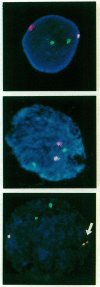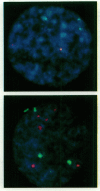Abstract
Numerical chromosome abnormalities were studied in single blastomeres from arrested or otherwise morphologically abnormal human preimplantation embryos. A 6-h FISH procedure with fluorochrome-labeled DNA probes was developed to determine numerical abnormalities of chromosomes X, Y, and 18. The three chromosomes were stained and detected simultaneously in 571 blastomeres from 131 embryos. Successful analysis including biopsy, fixation, and FISH analysis was achieved in 86.5% of all blastomeres. The procedure described here offers a reliable alternative to sexing of embryos by PCR and allows simultaneous ploidy assessment. For the three chromosomes tested, numerical aberrations were found in 56.5% of the embryos. Most abnormal embryos were polyploid or mosaics, and 6.1% were aneuploid for gonosomes or chromosome 18. Extrapolation of these results to all human chromosomes suggests that the majority of abnormally developing and arrested human embryos carry numerical chromosome abnormalities.
Full text
PDF
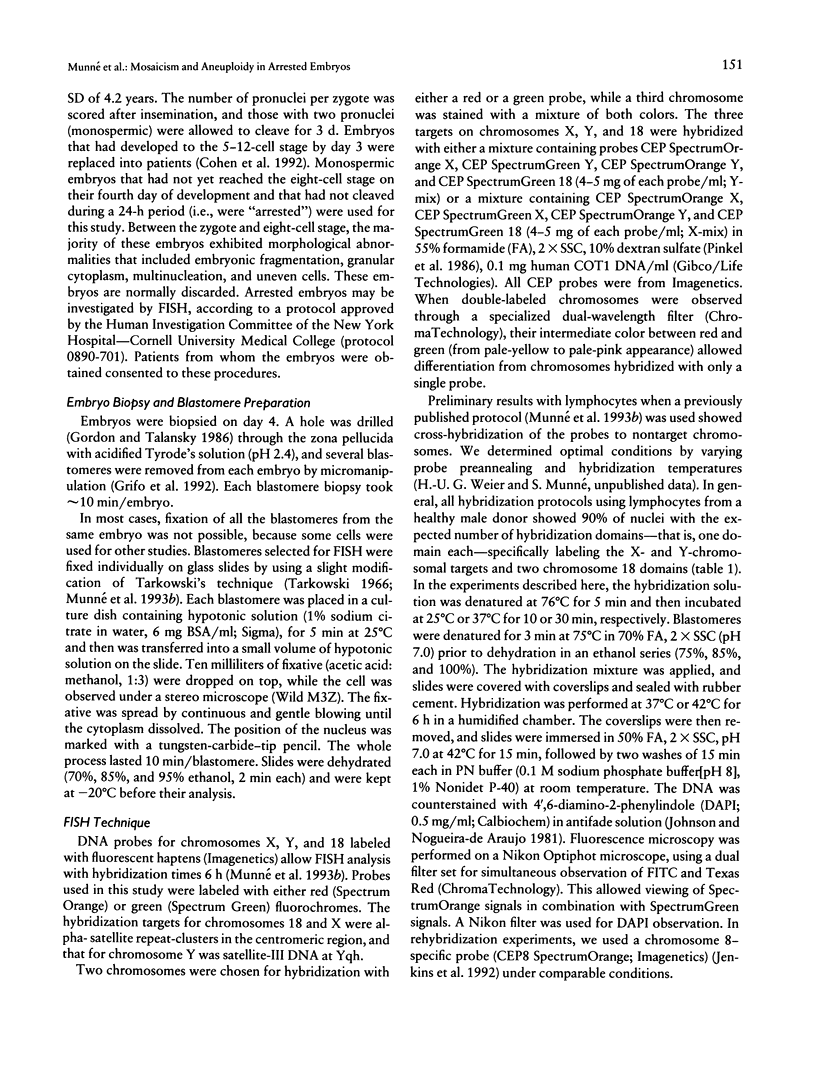
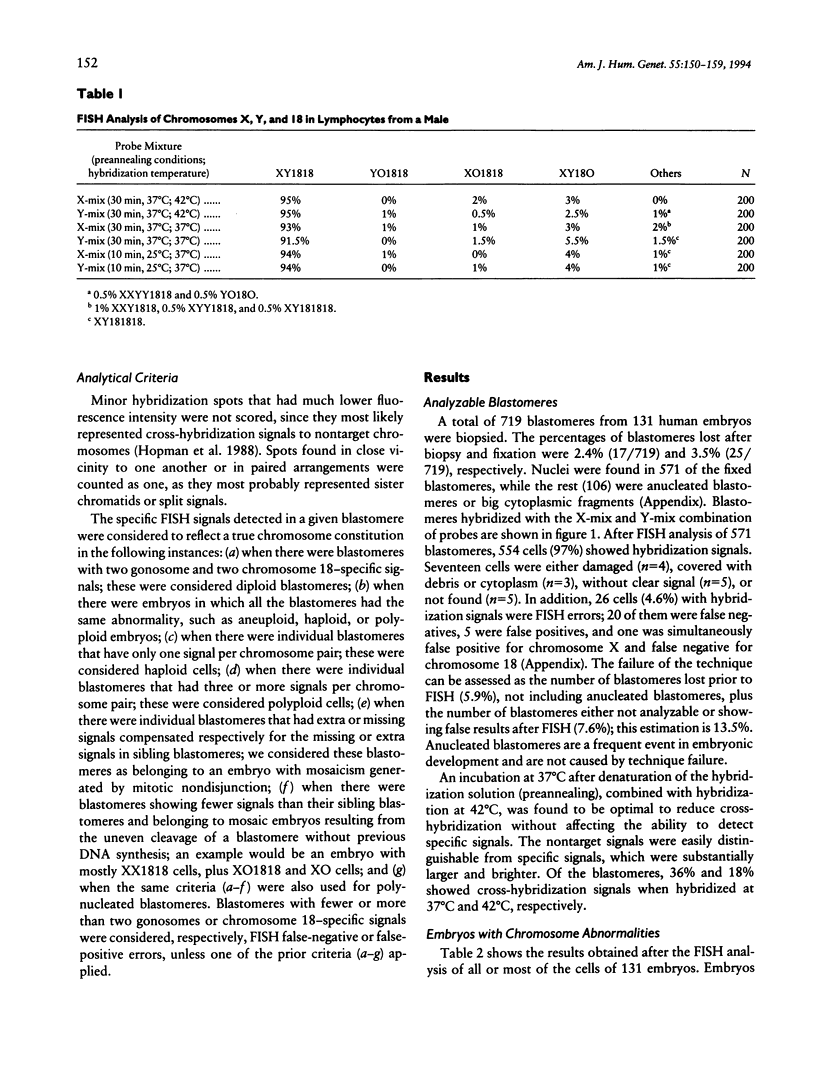
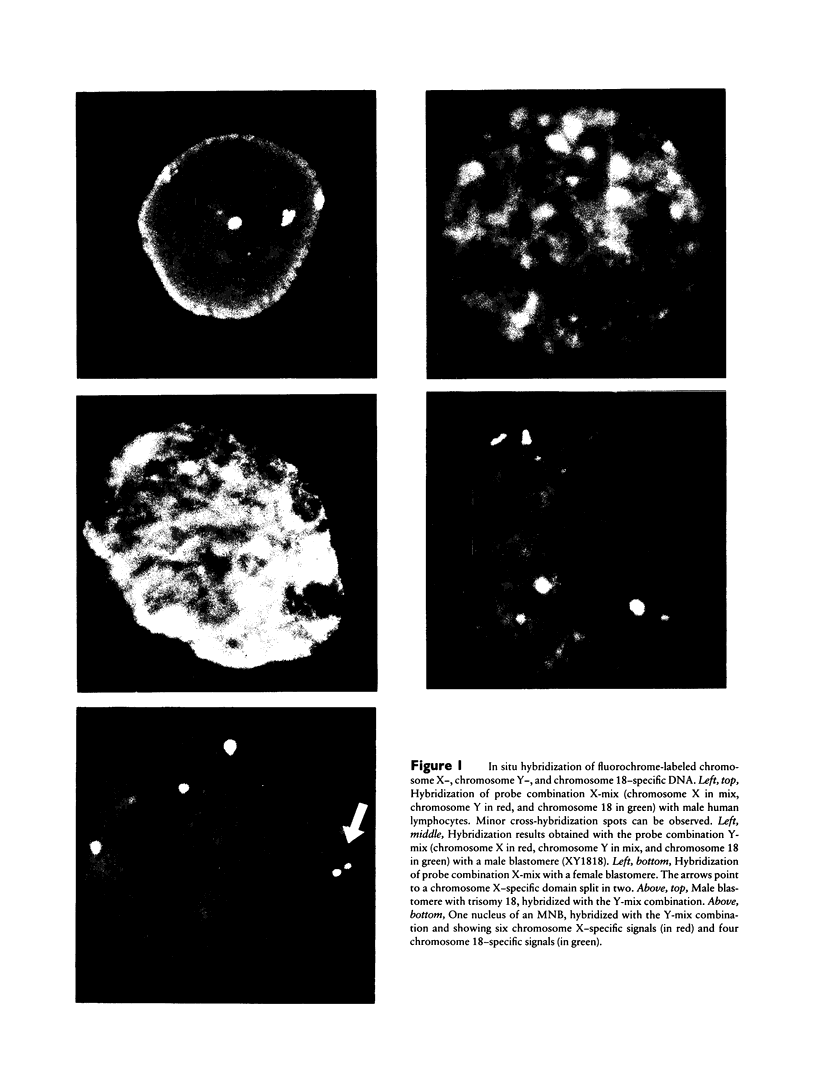
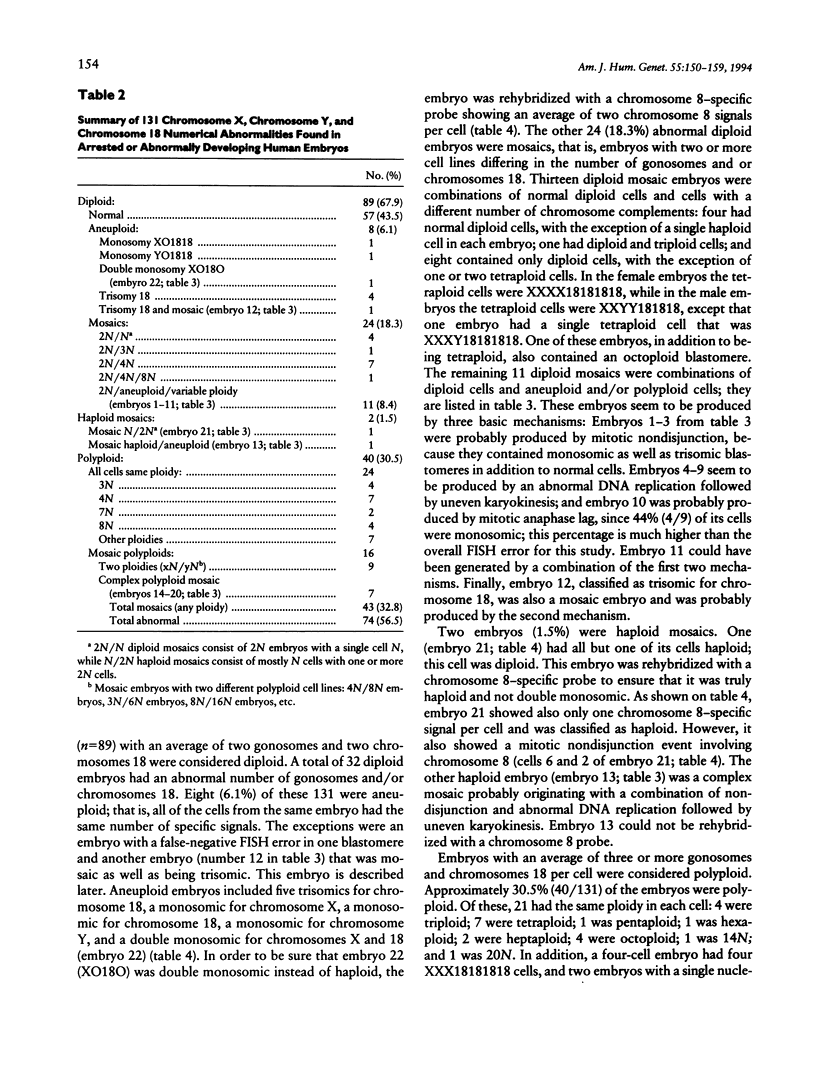
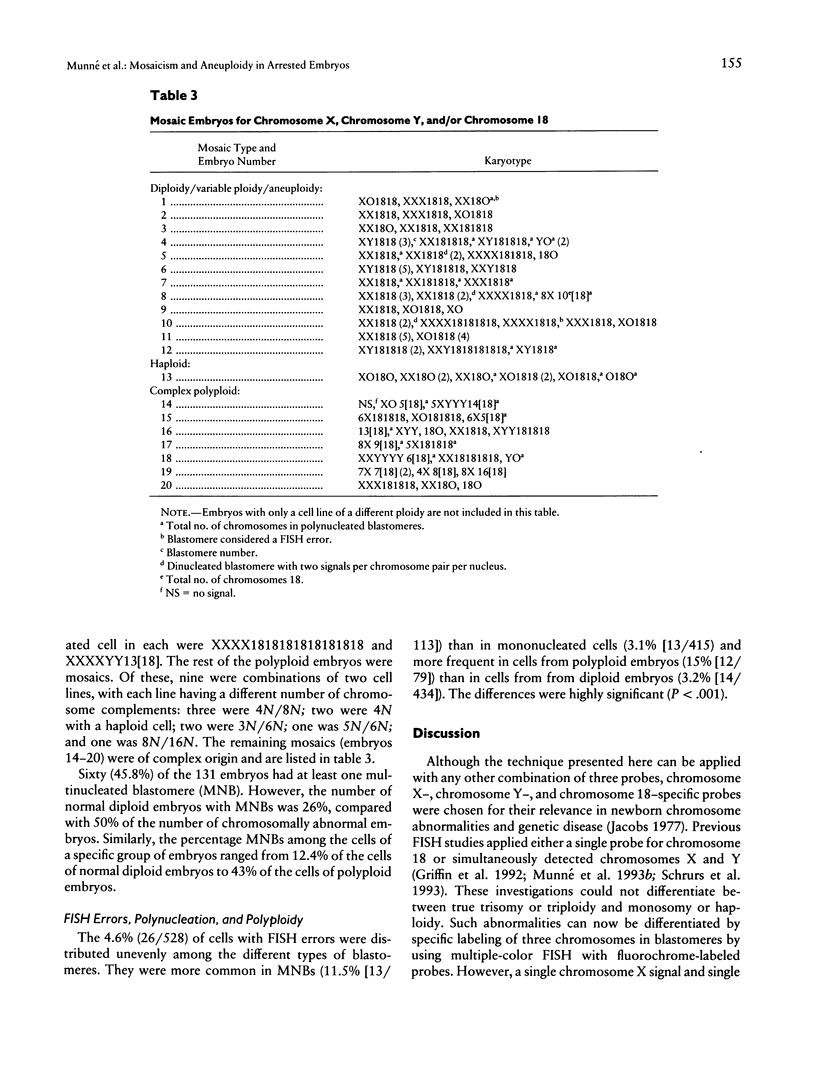
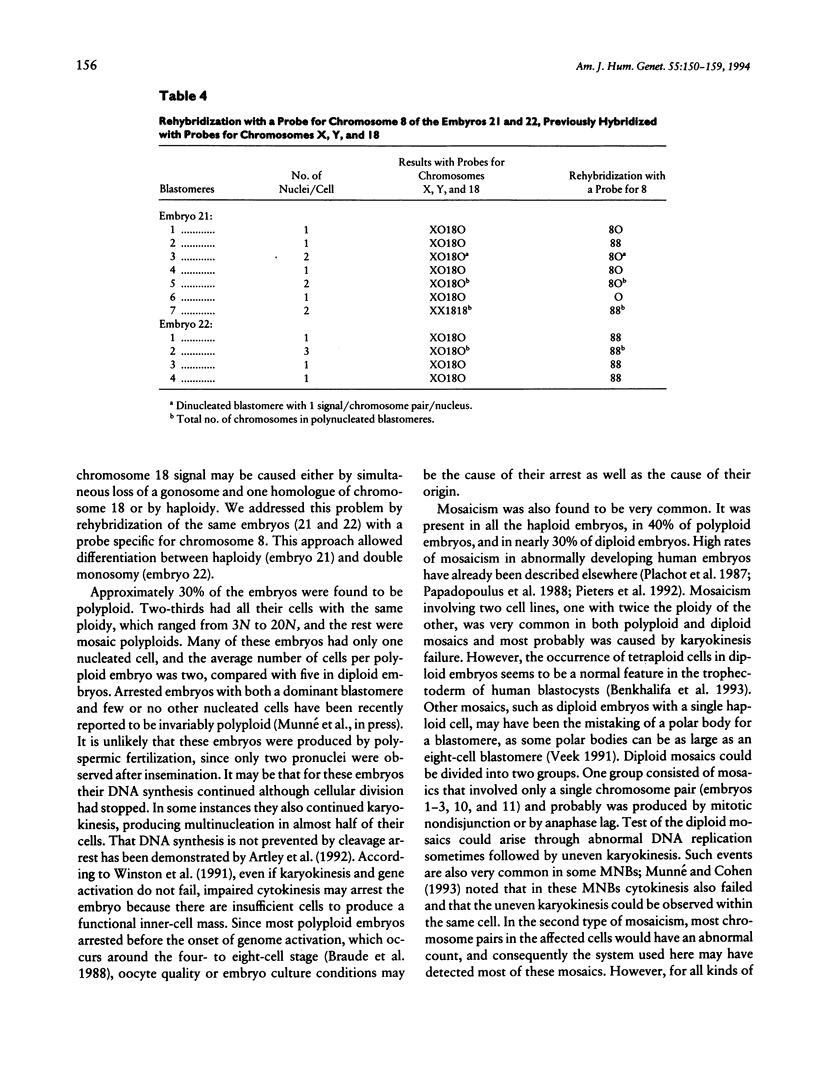

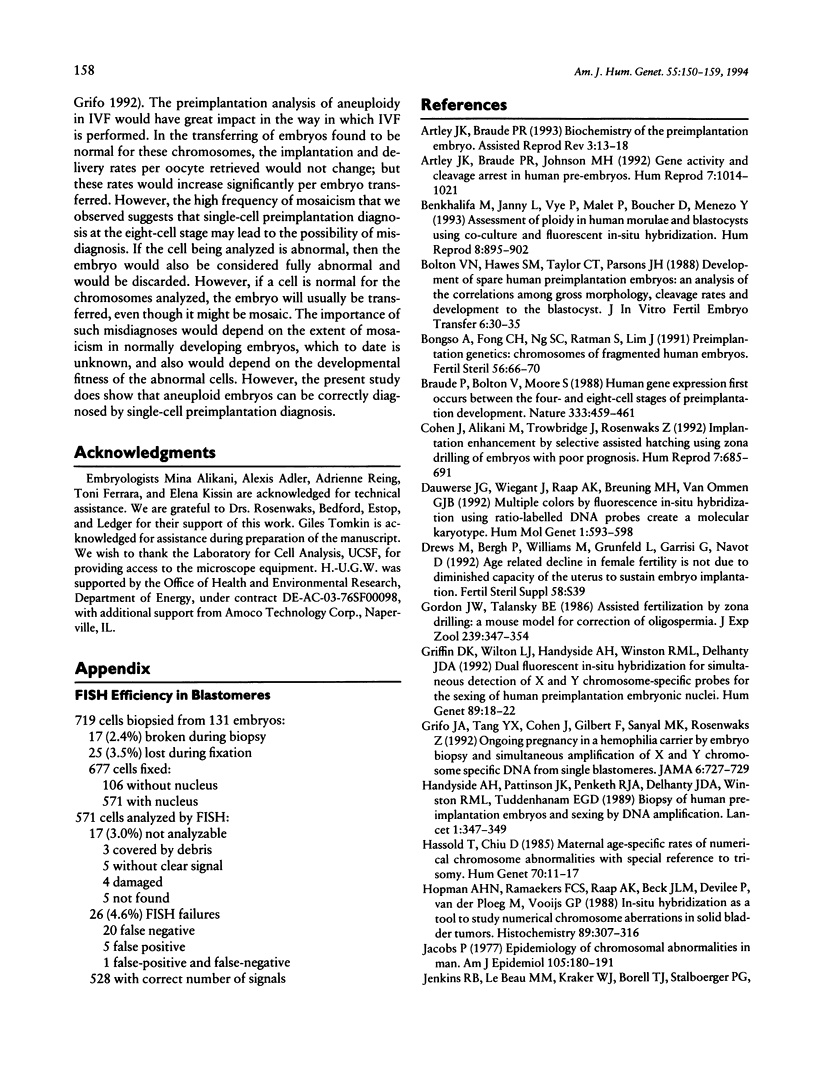
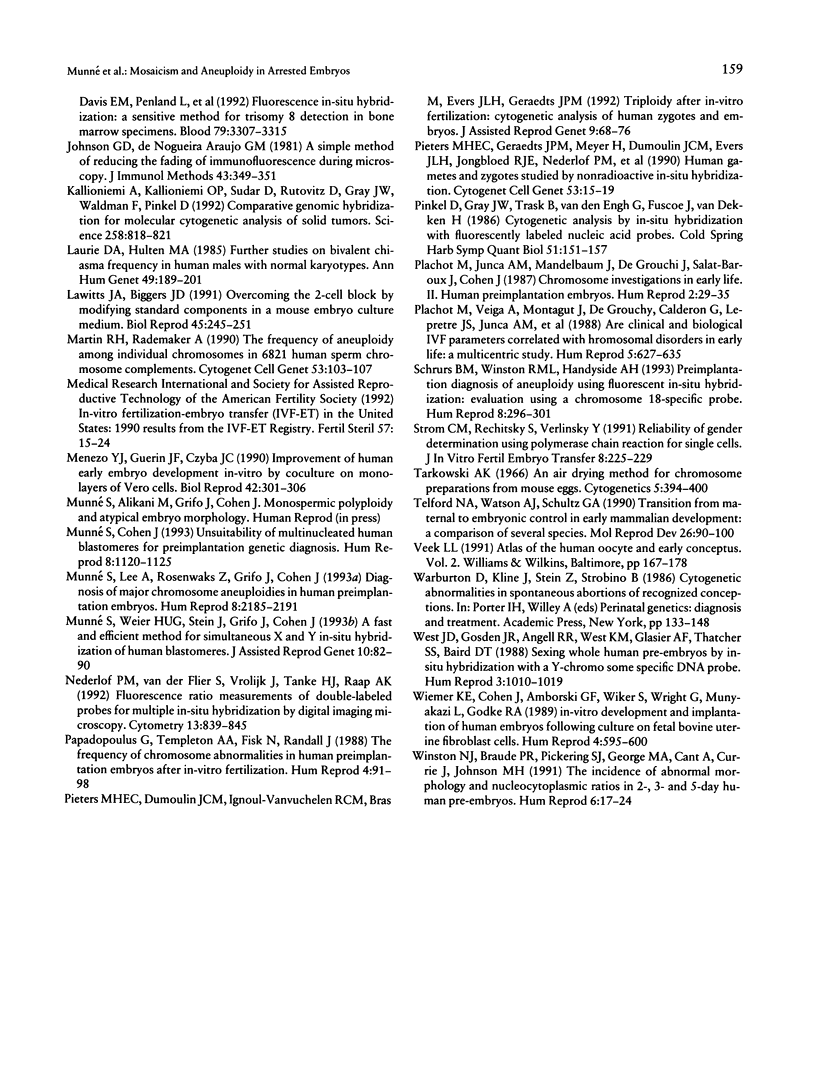
Images in this article
Selected References
These references are in PubMed. This may not be the complete list of references from this article.
- Artley J. K., Braude P. R., Johnson M. H. Gene activity and cleavage arrest in human pre-embryos. Hum Reprod. 1992 Aug;7(7):1014–1021. doi: 10.1093/oxfordjournals.humrep.a137761. [DOI] [PubMed] [Google Scholar]
- Benkhalifa M., Janny L., Vye P., Malet P., Boucher D., Menezo Y. Assessment of polyploidy in human morulae and blastocysts using co-culture and fluorescent in-situ hybridization. Hum Reprod. 1993 Jun;8(6):895–902. doi: 10.1093/oxfordjournals.humrep.a138162. [DOI] [PubMed] [Google Scholar]
- Bolton V. N., Hawes S. M., Taylor C. T., Parsons J. H. Development of spare human preimplantation embryos in vitro: an analysis of the correlations among gross morphology, cleavage rates, and development to the blastocyst. J In Vitro Fert Embryo Transf. 1989 Feb;6(1):30–35. doi: 10.1007/BF01134578. [DOI] [PubMed] [Google Scholar]
- Bongso A., Ng S. C., Lim J., Fong C. Y., Ratnam S. Preimplantation genetics: chromosomes of fragmented human embryos. Fertil Steril. 1991 Jul;56(1):66–70. doi: 10.1016/s0015-0282(16)54418-5. [DOI] [PubMed] [Google Scholar]
- Braude P., Bolton V., Moore S. Human gene expression first occurs between the four- and eight-cell stages of preimplantation development. Nature. 1988 Mar 31;332(6163):459–461. doi: 10.1038/332459a0. [DOI] [PubMed] [Google Scholar]
- Cohen J., Alikani M., Trowbridge J., Rosenwaks Z. Implantation enhancement by selective assisted hatching using zona drilling of human embryos with poor prognosis. Hum Reprod. 1992 May;7(5):685–691. doi: 10.1093/oxfordjournals.humrep.a137720. [DOI] [PubMed] [Google Scholar]
- Dauwerse J. G., Wiegant J., Raap A. K., Breuning M. H., van Ommen G. J. Multiple colors by fluorescence in situ hybridization using ratio-labelled DNA probes create a molecular karyotype. Hum Mol Genet. 1992 Nov;1(8):593–598. doi: 10.1093/hmg/1.8.593. [DOI] [PubMed] [Google Scholar]
- Gordon J. W., Talansky B. E. Assisted fertilization by zona drilling: a mouse model for correction of oligospermia. J Exp Zool. 1986 Sep;239(3):347–354. doi: 10.1002/jez.1402390306. [DOI] [PubMed] [Google Scholar]
- Griffin D. K., Wilton L. J., Handyside A. H., Winston R. M., Delhanty J. D. Dual fluorescent in situ hybridisation for simultaneous detection of X and Y chromosome-specific probes for the sexing of human preimplantation embryonic nuclei. Hum Genet. 1992 Apr;89(1):18–22. doi: 10.1007/BF00207035. [DOI] [PubMed] [Google Scholar]
- Grifo J. A., Tang Y. X., Cohen J., Gilbert F., Sanyal M. K., Rosenwaks Z. Pregnancy after embryo biopsy and coamplification of DNA from X and Y chromosomes. JAMA. 1992 Aug 12;268(6):727–729. [PubMed] [Google Scholar]
- Handyside A. H., Pattinson J. K., Penketh R. J., Delhanty J. D., Winston R. M., Tuddenham E. G. Biopsy of human preimplantation embryos and sexing by DNA amplification. Lancet. 1989 Feb 18;1(8634):347–349. doi: 10.1016/s0140-6736(89)91723-6. [DOI] [PubMed] [Google Scholar]
- Hassold T., Chiu D. Maternal age-specific rates of numerical chromosome abnormalities with special reference to trisomy. Hum Genet. 1985;70(1):11–17. doi: 10.1007/BF00389450. [DOI] [PubMed] [Google Scholar]
- Hopman A. H., Ramaekers F. C., Raap A. K., Beck J. L., Devilee P., van der Ploeg M., Vooijs G. P. In situ hybridization as a tool to study numerical chromosome aberrations in solid bladder tumors. Histochemistry. 1988;89(4):307–316. doi: 10.1007/BF00500631. [DOI] [PubMed] [Google Scholar]
- Jacobs P. A. Epidemiology of chromosome abnormalities in man. Am J Epidemiol. 1977 Mar;105(3):180–191. doi: 10.1093/oxfordjournals.aje.a112374. [DOI] [PubMed] [Google Scholar]
- Jenkins R. B., Le Beau M. M., Kraker W. J., Borell T. J., Stalboerger P. G., Davis E. M., Penland L., Fernald A., Espinosa R., 3rd, Schaid D. J. Fluorescence in situ hybridization: a sensitive method for trisomy 8 detection in bone marrow specimens. Blood. 1992 Jun 15;79(12):3307–3315. [PubMed] [Google Scholar]
- Johnson G. D., Nogueira Araujo G. M. A simple method of reducing the fading of immunofluorescence during microscopy. J Immunol Methods. 1981;43(3):349–350. doi: 10.1016/0022-1759(81)90183-6. [DOI] [PubMed] [Google Scholar]
- Kallioniemi A., Kallioniemi O. P., Sudar D., Rutovitz D., Gray J. W., Waldman F., Pinkel D. Comparative genomic hybridization for molecular cytogenetic analysis of solid tumors. Science. 1992 Oct 30;258(5083):818–821. doi: 10.1126/science.1359641. [DOI] [PubMed] [Google Scholar]
- Laurie D. A., Hultén M. A. Further studies on bivalent chiasma frequency in human males with normal karyotypes. Ann Hum Genet. 1985 Jul;49(Pt 3):189–201. doi: 10.1111/j.1469-1809.1985.tb01693.x. [DOI] [PubMed] [Google Scholar]
- Lawitts J. A., Biggers J. D. Overcoming the 2-cell block by modifying standard components in a mouse embryo culture medium. Biol Reprod. 1991 Aug;45(2):245–251. doi: 10.1095/biolreprod45.2.245. [DOI] [PubMed] [Google Scholar]
- Martin R. H., Rademaker A. The frequency of aneuploidy among individual chromosomes in 6,821 human sperm chromosome complements. Cytogenet Cell Genet. 1990;53(2-3):103–107. doi: 10.1159/000132905. [DOI] [PubMed] [Google Scholar]
- Menezo Y. J., Guerin J. F., Czyba J. C. Improvement of human early embryo development in vitro by coculture on monolayers of Vero cells. Biol Reprod. 1990 Feb;42(2):301–306. doi: 10.1095/biolreprod42.2.301. [DOI] [PubMed] [Google Scholar]
- Munné S., Cohen J. Unsuitability of multinucleated human blastomeres for preimplantation genetic diagnosis. Hum Reprod. 1993 Jul;8(7):1120–1125. doi: 10.1093/oxfordjournals.humrep.a138204. [DOI] [PubMed] [Google Scholar]
- Munné S., Lee A., Rosenwaks Z., Grifo J., Cohen J. Diagnosis of major chromosome aneuploidies in human preimplantation embryos. Hum Reprod. 1993 Dec;8(12):2185–2191. doi: 10.1093/oxfordjournals.humrep.a138001. [DOI] [PubMed] [Google Scholar]
- Munné S., Weier H. U., Stein J., Grifo J., Cohen J. A fast and efficient method for simultaneous X and Y in situ hybridization of human blastomeres. J Assist Reprod Genet. 1993 Jan;10(1):82–90. doi: 10.1007/BF01204446. [DOI] [PubMed] [Google Scholar]
- Nederlof P. M., van der Flier S., Vrolijk J., Tanke H. J., Raap A. K. Fluorescence ratio measurements of double-labeled probes for multiple in situ hybridization by digital imaging microscopy. Cytometry. 1992;13(8):839–845. doi: 10.1002/cyto.990130806. [DOI] [PubMed] [Google Scholar]
- Papadopoulos G., Templeton A. A., Fisk N., Randall J. The frequency of chromosome anomalies in human preimplantation embryos after in-vitro fertilization. Hum Reprod. 1989 Jan;4(1):91–98. doi: 10.1093/oxfordjournals.humrep.a136853. [DOI] [PubMed] [Google Scholar]
- Pieters M. H., Dumoulin J. C., Ignoul-Vanvuchelen R. C., Bras M., Evers J. L., Geraedts J. P. Triploidy after in vitro fertilization: cytogenetic analysis of human zygotes and embryos. J Assist Reprod Genet. 1992 Feb;9(1):68–76. doi: 10.1007/BF01204118. [DOI] [PubMed] [Google Scholar]
- Pieters M. H., Geraedts J. P., Meyer H., Dumoulin J. C., Evers J. L., Jongbloed R. J., Nederlof P. M., van der Flier S. Human gametes and zygotes studied by nonradioactive in situ hybridization. Cytogenet Cell Genet. 1990;53(1):15–19. doi: 10.1159/000132886. [DOI] [PubMed] [Google Scholar]
- Pinkel D., Gray J. W., Trask B., van den Engh G., Fuscoe J., van Dekken H. Cytogenetic analysis by in situ hybridization with fluorescently labeled nucleic acid probes. Cold Spring Harb Symp Quant Biol. 1986;51(Pt 1):151–157. doi: 10.1101/sqb.1986.051.01.018. [DOI] [PubMed] [Google Scholar]
- Plachot M., Junca A. M., Mandelbaum J., de Grouchy J., Salat-Baroux J., Cohen J. Chromosome investigations in early life. II. Human preimplantation embryos. Hum Reprod. 1987 Jan;2(1):29–35. doi: 10.1093/oxfordjournals.humrep.a136484. [DOI] [PubMed] [Google Scholar]
- Plachot M., Veiga A., Montagut J., de Grouchy J., Calderon G., Lepretre S., Junca A. M., Santalo J., Carles E., Mandelbaum J. Are clinical and biological IVF parameters correlated with chromosomal disorders in early life: a multicentric study. Hum Reprod. 1988 Jul;3(5):627–635. doi: 10.1093/oxfordjournals.humrep.a136758. [DOI] [PubMed] [Google Scholar]
- Schrurs B. M., Winston R. M., Handyside A. H. Preimplantation diagnosis of aneuploidy using fluorescent in-situ hybridization: evaluation using a chromosome 18-specific probe. Hum Reprod. 1993 Feb;8(2):296–301. doi: 10.1093/oxfordjournals.humrep.a138040. [DOI] [PubMed] [Google Scholar]
- Strom C. M., Rechitsky S., Verlinsky Y. Reliability of gender determination using the polymerase chain reaction (PCR) for single cells. J In Vitro Fert Embryo Transf. 1991 Aug;8(4):225–229. doi: 10.1007/BF01130810. [DOI] [PubMed] [Google Scholar]
- Telford N. A., Watson A. J., Schultz G. A. Transition from maternal to embryonic control in early mammalian development: a comparison of several species. Mol Reprod Dev. 1990 May;26(1):90–100. doi: 10.1002/mrd.1080260113. [DOI] [PubMed] [Google Scholar]
- West J. D., Gosden J. R., Angell R. R., West K. M., Glasier A. F., Thatcher S. S., Baird D. T. Sexing whole human pre-embryos by in-situ hybridization with a Y-chromosome specific DNA probe. Hum Reprod. 1988 Nov;3(8):1010–1019. doi: 10.1093/oxfordjournals.humrep.a136814. [DOI] [PubMed] [Google Scholar]
- Wiemer K. E., Cohen J., Amborski G. F., Wright G., Wiker S., Munyakazi L., Godke R. A. In-vitro development and implantation of human embryos following culture on fetal bovine uterine fibroblast cells. Hum Reprod. 1989 Jul;4(5):595–600. doi: 10.1093/oxfordjournals.humrep.a136949. [DOI] [PubMed] [Google Scholar]
- Winston N. J., Braude P. R., Pickering S. J., George M. A., Cant A., Currie J., Johnson M. H. The incidence of abnormal morphology and nucleocytoplasmic ratios in 2-, 3- and 5-day human pre-embryos. Hum Reprod. 1991 Jan;6(1):17–24. doi: 10.1093/oxfordjournals.humrep.a137253. [DOI] [PubMed] [Google Scholar]



